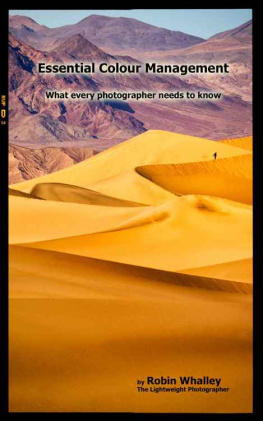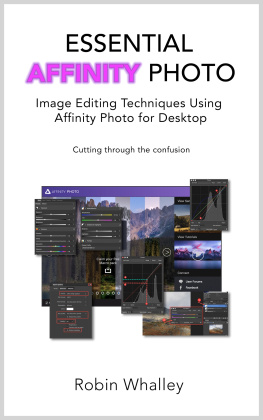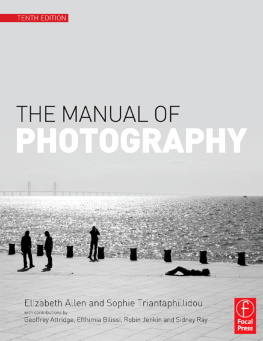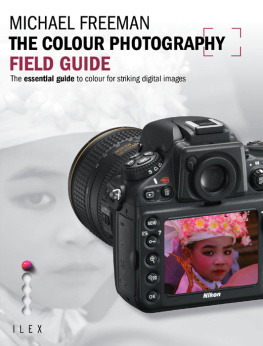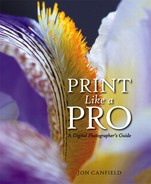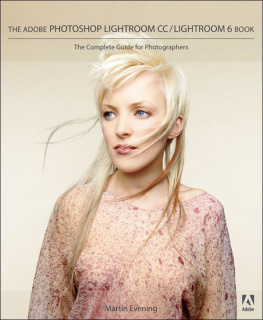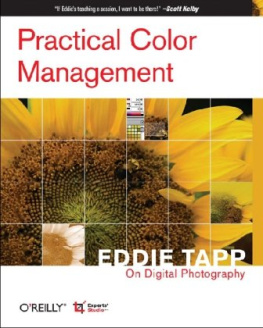Essential Colour Management
What every photographer needs to know
by Robin Whalley
(The Lightweight Photographer)
Text copyright 2013: Robin Whalley
All Rights reserved
Contents
If you are w ondering where the page numbers are in the table of contents below, this book was developed exclusively for the Kindle, where page numbering isnt currently supported.
The Lightweight Photography Philosophy
Before we delve into the subject of Colour Management its worth taking a moment to understand the Lightweight Photography Philosophy and how it makes this book special.
The Lightweight Philosophy doesnt mean that you don't do photography properly; it means that you streamline and simplify your photography, allowing you to achieve better results. For example, by limiting the weight, size and quantity of equipment, you can free yourself to work more creatively. You might also enjoy your photography a little more. The only caveat to this approach is that the technical quality of the images must not be compromised.
But t he "Lightweight" approach isn't limited to equipment; it also extends into the world of post processing. Photographers need powerful but simple tools that allow them to quickly create work that realises their vision. Too often complicated software stands in the way of realising an images true potential. I doubt there are few subjects where this is more in evidence than with Colour Management.
The fragmented tools and techniques we need to work with have been overly complicated by huge books often filled with irrelevant detail. These claim to explain everything you need to know but often leave you confused as to how to put the information into practice. You don't need to know everything you only need to understand the essentials.
This book takes an entirely different approach to the subject of Colour Management. It strips back the information to those essential points that you simply can't function without. It also approaches the subject from a photographer's perspective rather than a digital artist or print publisher.
All t he books I publish have a single objective; to provide you the reader with the photography skills you need to create breathtaking images, without requiring you to wade through worthless filler content. This makes my books a reasonable length whilst being comprehensive and very accessible.
If you want to know more about the philosophy of Lightweight Photography you can visit and subscribe to my blog at http://thelightweightphotographer.com .
To download the supporting files for this book sign up (for free) as a member of my website ( ). Here you will find under the Members Area, a page of Useful Downloads including supporting files for this book.
Is this Book for You
Not everyone will need this book. If you are an expert in colour management already or are happy that you understand enough to achieve consistently good results, then it's probably not for you. If you are a graphic artist and not interested in photography then again it's probably not for you.
If however you are a photographer and find yourself constantly frustrated because your images never appear as good as when viewed on your own monitor, or if you want to print your own Photographs but find they never come out looking as you thought they would, this book is definitely for you.
This book assumes you know nothing about Colour Management but will quickly guide you through the basics. You will gain an understanding of important concepts and tools to help you understand why something works. More importantly it will give you the knowledge and understanding to identify and correct the Colour Management problems you will almost certainly encounter.
Last but not least, if you find you are struggling with an aspect of the book, contact me using and I will try to help you further.
Trademarks
Throughout this book I have made reference to various organisations and their products. Where reference is made to any trademarks or product names within this book, the reference is made purely in an editorial capacity. There is no intention of Copyright infringement whatsoever and all trademarks are recognised.
Disclaimer
Whilst I have made every effort to ensure the information in this guide is accurate, up to date and factual, it does represent my views and approach. Some may disagree with the information I present but I have not intentionally made any omissions or errors. If you do find something you believe needs to be corrected please contact me by email using .
Thanks and enjoy the book.
Introduction
I know of no other subject in Photography that causes as much confusion and frustration as Colour Management. Much of this confusion has come about as a result of our move away from analogue photography and into a digital world. Add to this a combination of overly complex, poorly presented and in some cases incorrect information and it's little wonder people encounter problems. The bad news is that Colour Management is an essential subject that will impact (probably negatively) every serious photographer. The good news is that it can be reduced to a set of essential principles that are relatively easy to master with a little time and effort.
This book presents the basics of what you need to know about how to manage colour as a photographer. Some of the subject matter may at first seem complex but once you understand the core elements everything will slot into place.
This book is also intentionally quite short at around 21,000 words. This is to ensure it is accessible and easily digested. There are plenty more complex books that you can turn to after this one should you wish to expand your knowledge. I dont however believe that another complex book is what the photography world needs or wants at this time.
The content of the book is structured to build your knowledge from nothing to a point where you can understand and implement your own colour management process. Each topic will build on the previous until you have a complete understanding of the essentials. You therefore need to ensure you read the book fully, sequentially and probably a couple of times there is a lot of information conveyed in a very condensed fashion.
Please also don't be tempted to skip any of the sections thinking that they don't apply to you. For example, if you are a Photoshop user but don't use Lightroom, please still read the Lightroom sections. I often introduce new, important information in such sections so please read everything.
At various points in the text I make reference to particular products and include links to websites such as Amazon. In some instances, I receive an associate commission which I use to maintain my blog and website, keeping them free for all to use. I tell you this to be entirely transparent and to assure you that:
- I will never recommend anything that I dont believe in.
- Clicking these links to make a purchase costs you nothing extra.
If you do decide to make any purchases based on the information in this book, p lease support me by using these links. It's greatly appreciated.
Finally I would like to point out that I use the UK spelling of the word colour as I am based in the UK. At times I will also use the spelling color, especially where this relates to information appearing in software. This is to remain consistent with the screen shots presented.
I hope you enjoy the book.
Chapter One The Overview
A Definition
To start, lets clarify what we mean by the term colour management.
If you ask a group of photographers, m ost will define colour management as the process of making prints match what is seen on a computer monitor. In fact this is only one application of colour management and certainly isnt a helpful definition.

